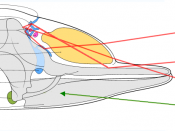Dolphin Communication and Fun Facts
The dolphin's intelligence, playfulness, and friendliness, its built-in smile and merry-looking eyes have been a source of interest and enchantment to human beings from the earliest times. It is a common figure in mythology and literature and has been much depicted in art, especially in the posture of its graceful, arched, 30-ft leap. However, not only is it interesting to the eyes but also it is also interesting to the ears.
For years researchers have been trying to answer the famous question, 'can dolphins communicate effectively?' Slowly more and more facts are being uncovered to help us better understand the ways in which dolphins communicate. There are also many little known facts that strike people surprisingly because dolphins are actually one of the most intriguing mammals in the ocean. In this paper I will explain the ways in which dolphins communicate and describe different facts about them.
Dolpins have a well-developed, acute sense of hearing. The auditory cortex of the brain, which is used for hearing, is highly developed. The auditory nerve may have 67,900 or more cochlear fibers. This is twice as many as in the human auditory nerve. Unlike humans, a dolphin's inner ear is encased in a separate bone, called the auditory bulla, which is connected to the skull with fibrous tissue (Senses 1). Thus, the bulla is essentially isolated from the skull, and sound enters the ear most efficiently through the jaw and middle ear. A fat-filled cavity in the lower jawbone appears to conduct sound waves through the jaw to bones in the middle ears. The lower jawbone of toothed whales broadens and is hollow at the base, where it hinges with the skull. Within this very thin, hollow bone is a fat deposit that extends back toward the auditory...


